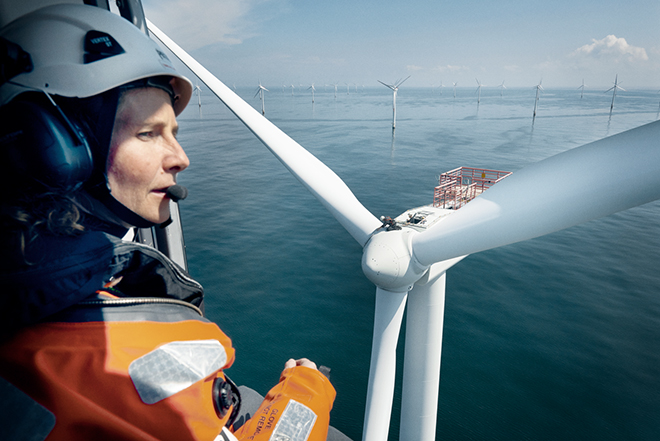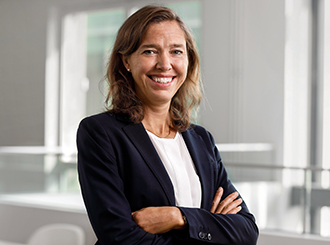S&P Global Offerings
Featured Topics
Featured Products
Events
S&P Global Offerings
Featured Topics
Featured Products
Events
S&P Global Offerings
Featured Topics
Featured Products
Events
Banking & Capital Markets
Economy & Finance
Energy Transition & Sustainability
Technology & Innovation
Podcasts & Newsletters
Banking & Capital Markets
Economy & Finance
Energy Transition & Sustainability
Technology & Innovation
Podcasts & Newsletters
S&P Global Offerings
Featured Topics
Featured Products
Events
22 Sep, 2021

By Camilla Naschert
 |
| A worker on an offshore wind farm. Accounting for just 21% of the global workforce, women are significantly underrepresented in the wind industry. Source: Vattenfall AB |
The race in Europe to rapidly ramp up renewables capacity could soon lead to a labor crunch with roles in engineering and project management becoming harder to fill, Vattenfall AB CFO Kerstin Ahlfont told S&P Global Market Intelligence.
The EU set a 300-GW offshore wind capacity target by 2050 and wants to see 40 GW of electrolysis installed for hydrogen production by the end of this decade, as well as expanding its onshore wind and solar fleets. Vattenfall itself is eyeing a fourfold increase in its wind and solar capacity.
"We're talking about large investments ... and, of course, all of this needs to be done by people," Ahlfont said in a Sept. 20 interview. "Here, we will see scarcity."
Onshore wind faces particular labor shortages, with roles increasingly difficult to fill as engineers drift into higher-paid and larger-scale offshore wind projects. Some 1.2 million people work in the global wind industry, of which 300,000 are in Europe, according to trade group WindEurope. By 2030, the organization expects this number to rise to 450,000, requiring a "skills and training revolution" to avoid a slowdown in the global energy transition.
"The [human] resource question is of key strategic importance to us," said Ahlfont, who became CFO in November 2020 after a stint as Vattenfall's head of human resources, replacing Anna Borg who was appointed to CEO.
The expansion of renewables, as well as much-needed upgrades for electricity grids across Europe, are coinciding with a demographic shift, resulting in shortages across ranks and disciplines. "Everything from project managers to different types of technical skills," Ahlfont said.
Gender diversity
Faced with a potential labor crunch, another key challenge for the energy sector is a gender imbalance in its workforce, with fewer women entering engineering jobs in many countries and a lack of gender diversity in boardrooms. Vattenfall and Engie SA, majority owned by the governments of Sweden and France, respectively, are the only major European utilities with women in both the CEO and CFO roles.
The gender divide varies across the European energy space: The representation of women in U.K. energy company boardrooms, for example, is "alarmingly low," according to a recent analysis.
Industrial powerhouse Germany, Europe's largest economy, introduced a minimum quota for women on the boards of large listed companies in January to force change at the top. German power producer Uniper SE said in January that it struggled to find suitable female candidates for its executive management roles before a board reshuffle by owner Fortum Oyj saw CFO Tiina Tuomela appointed. Ahlfont also noted an underrepresentation of women in Vattenfall's German business compared to other countries in the utility's scope.
 |
| Vattenfall CFO Kerstin Ahlfont. Source: Vattenfall AB |
"If we are to reach these [capacity] targets, we cannot exclude parts of the potential workforce, be it women or be it any ethnic background. We need to search everywhere for these resources, and we as a company need to make sure we are attractive for all different types of diversity aspects," Ahlfont said.
Women are still underrepresented in the wind industry. A 2020 survey by the International Renewable Energy Agency, or IRENA, showed that women represent 21% of the wind energy workforce globally, compared to 32% in renewables overall and 22% in traditional energy industries like oil and gas.
The survey also showed that a perceived lack of fairness is a significant barrier to retention, Rabia Ferroukhi, director of IRENA's knowledge, policy and finance center, said on a Sept. 20 webinar hosted by industry website Recharge.
"Respondents clearly show that the main problem is a perception of gender roles ... that influence decisions people make," Ferroukhi said, adding that women in the sector also still experience difficulties in accessing professional networks.
Therefore, increasing diversity requires corporate intention, starting with the hiring and onboarding process, according to Abby Watson, head of government affairs for North America at wind-turbine maker Siemens Gamesa Renewable Energy SA. "When you talk about recruitment and bringing candidates in who may not look like the team they are joining ... that can be a really uncomfortable experience," Watson said on the webinar. "That onboarding experience ... is one of the most difficult things to get right consistently."
Inclusion starts with the job description, and there are words such as "champion" or "strong" that might turn women off from applying for roles, Jenneke Verhoef, technical general manager in Royal Dutch Shell PLC's offshore wind division, said during the Recharge event. "Processes around diversity are important, but you need more than just that. Make it a safe culture for women to speak up, and be aware of the bias you may have," Verhoef said.
Some progress has already been made, for example, in Taiwan. According to Marina Hsu, managing director of Copenhagen Infrastructure Partners K/S's Taiwanese wind development unit, there has been a sea change in the local offshore wind industry, which 10 years ago was still in its infancy and deemed an unsuitable sector for women. Today, a majority of company executives in the Taiwanese offshore wind industry are women, Hsu said on the webinar.
In order to encourage more women to consider careers in the wind sector, CIP is speaking at all-girls high schools in Taiwan to make a case for the industry and outline the opportunities, which also involves bringing parents on board. "In Asian society, expectations on women and girls are perhaps even more stifling than in the West," Hsu said.
